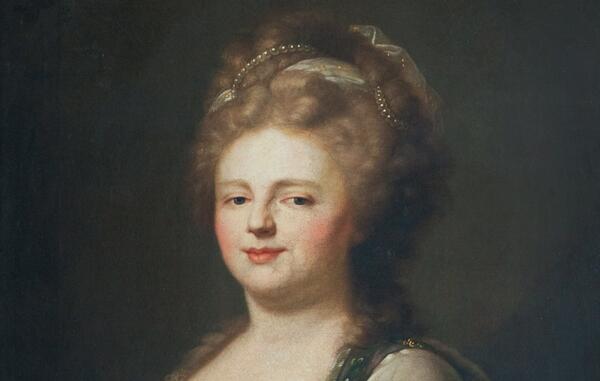The portrait of Mariya Feodorovna from the collection in the Old Mansion was made by an unknown artist at the end of the 18th century. Judging by the exquisite manner of painting and complex color shades, it was a metropolitan master. The iconographic type goes back to the half-length portrait by Johann Baptist von Lampi the Elder.
The term ‘iconographic’ in this case has nothing to do with icon painting. In a broad sense, iconography is the canonical image system, that is, the repetition of the characteristic features of the image from canvas to canvas. Iconographic types in Russia were characteristic of the official secular art. Often the royal family invited the best portrait painters from abroad to create an exemplary portrait, which, in turn, could be copied by Russian painters. Such canvases adorned ‘public places’ — reception rooms and offices of state institutions. A copy of an exemplary portrait could be placed in their galleries and the highest nobility.
The Austrian artist Johann Baptist von Lampi the Elder was invited to Russia by Catherine II. His Serene Highness Prince Grigory Potemkin-Tavrichesky introduced the empress to his works. Previously, the painter created portraits of both Potemkin himself and nobles from his entourage.
At the Russian court, Lampi painted a full-length ceremonial portrait of Catherine II from life. For this work, he was paid 12,000 rubles (this is three annual earnings of a petty official) and was assigned an annual allowance of 1,000 rubles.
In 1794, for the portrait of Count Alexey Musin-Pushkin, Lampi received the title of an honorary free associate of the Imperial Academy of Arts. This title was awarded when the Academy noted the merits of the painter but for formal reasons could not award him the title of a class artist or academician. Foreign specialists often became free associates.
Lampi gave private lessons in Russia, including to the young portrait painter Vladimir Borovikovsky. He also influenced Dmitry Levitsky. The peculiarity of Lampi’s painting style was that the artist made the rich colors of the paintings delicate and muted. He used smooth strokes that softened the transitions between shades and the contrast between shadow and light. This technique made Lumpy the Elder one of the finest portrait painters of his time.
Lampi also painted a full-length portrait of Mariya Fedorovna, the wife of Paul I. Before that, he prepared a study depicting the Empress half-length. This canvas is now kept in the Saratov Art Museum named after Alexander N. Radishchev. Perhaps, in those years, the portrait of Mariya Feodorovna, which is now presented in the Old Mansion, was created from it.
The term ‘iconographic’ in this case has nothing to do with icon painting. In a broad sense, iconography is the canonical image system, that is, the repetition of the characteristic features of the image from canvas to canvas. Iconographic types in Russia were characteristic of the official secular art. Often the royal family invited the best portrait painters from abroad to create an exemplary portrait, which, in turn, could be copied by Russian painters. Such canvases adorned ‘public places’ — reception rooms and offices of state institutions. A copy of an exemplary portrait could be placed in their galleries and the highest nobility.
The Austrian artist Johann Baptist von Lampi the Elder was invited to Russia by Catherine II. His Serene Highness Prince Grigory Potemkin-Tavrichesky introduced the empress to his works. Previously, the painter created portraits of both Potemkin himself and nobles from his entourage.
At the Russian court, Lampi painted a full-length ceremonial portrait of Catherine II from life. For this work, he was paid 12,000 rubles (this is three annual earnings of a petty official) and was assigned an annual allowance of 1,000 rubles.
In 1794, for the portrait of Count Alexey Musin-Pushkin, Lampi received the title of an honorary free associate of the Imperial Academy of Arts. This title was awarded when the Academy noted the merits of the painter but for formal reasons could not award him the title of a class artist or academician. Foreign specialists often became free associates.
Lampi gave private lessons in Russia, including to the young portrait painter Vladimir Borovikovsky. He also influenced Dmitry Levitsky. The peculiarity of Lampi’s painting style was that the artist made the rich colors of the paintings delicate and muted. He used smooth strokes that softened the transitions between shades and the contrast between shadow and light. This technique made Lumpy the Elder one of the finest portrait painters of his time.
Lampi also painted a full-length portrait of Mariya Fedorovna, the wife of Paul I. Before that, he prepared a study depicting the Empress half-length. This canvas is now kept in the Saratov Art Museum named after Alexander N. Radishchev. Perhaps, in those years, the portrait of Mariya Feodorovna, which is now presented in the Old Mansion, was created from it.



